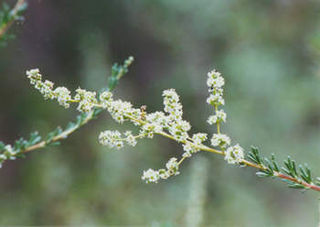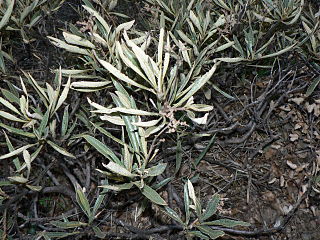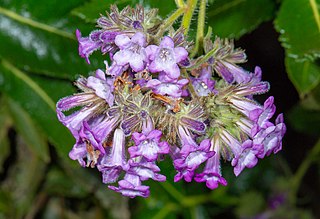
Marah oreganus, the Oregon manroot, coastal manroot or western wild-cucumber, is a common manroot of the northwest coast of the United States. It ranges from California north to Canada.

Adenostoma fasciculatum, commonly known as chamise or greasewood, is a flowering plant native to California and Baja California. This shrub is one of the most widespread plants of the California chaparral ecoregion. Chamise produces a specialized lignotuber underground and at the base of the stem, known as a burl, that allow it to resprout after fire has off burned its stems. It is noted for its greasy, resinous foliage, and its status as one of California's most iconic chaparral shrubs.

Artemisia californica, also known as California sagebrush, is a species of western North American shrub in the sunflower family.

Rhus ovata, commonly known as sugar bush or sugar sumac, is a shrub or small tree found growing in the canyons and slopes of the chaparral and related ecosystems in Southern California, Arizona, Baja California and Baja California Sur. It is a long lived-plant, up to 100 years, and has dense evergreen foliage that make it conspicuous. It is closely related to and hybridizes with the lemonade sumac.

Eriodictyon is a genus of plants known by the common name yerba santa within the Hydrophylloideae subfamily of the borage family, Boraginaceae. They are distributed throughout the southwestern United States and Mexico.

Eriodictyon californicum is a species of plant within the family Boraginaceae. It is also known as yerba santa, mountain balm, bear's weed, gum bush, gum plant, and consumptive weed. Less common names include Herbe des Montagnes, Herbe à Ourse, Herbe Sacrée, Herbe Sainte, Hierba Santa, Holy Herb, and Tarweed.

The monotypic genus Anemopsis has only one species, Anemopsis californica, with the common names yerba mansa or lizard tail.

Eriodictyon angustifolium, common name narrowleaf yerba santa, is a perennial shrub.

Eriodictyon crassifolium, or thickleaf yerba santa, is a shrub in the borage family. "Crassifolium" means "thick leaf." The plant has thick, wooly leaves. It is native to California and Baja California.

Eriodictyon capitatum, the Lompoc yerba santa, is a rare evergreen shrub in the borage family. It is endemic to western Santa Barbara County, in California.

Homoeriodictyol is a bitter-masking flavanone extracted from Yerba Santa a plant growing in America.

Eriodictyon tomentosum is a species of flowering plant in the borage family known by the common name woolly yerba santa. It is endemic to California, where it grows on the slopes of the central coast ranges.
Eriodictyon traskiae is a species of flowering plant in the waterleaf family known by the common names Pacific yerba santa and Trask's yerba santa.

Eriodictyon parryi or poodle-dog bush is a tall California mountain shrub with showy purple flowers, which is notable for secreting a severe skin irritant. It is an opportunistic species that grows mostly in areas that have been disturbed by fire. In a dry early spring in Southern California, its semi-dormant leaves can droop and curl into coils like locks of curly hair, hence the popular name based on the metaphor of a poodle's natural hair.
The Mediterranean California lower montane black oak–conifer forest is a major forest association and ecosystem of the California mixed evergreen forest bioregion in certain mountain ranges in California and southern Oregon in the Western United States; and Baja California in northwest Mexico.

Eriodictyon lobbii is a species of flowering plant in the borage family known by the common names Lobb's fiddleleaf and matted yerba santa. It is native to the Sierra Nevada and southern Cascade Range chain in California and adjacent sections of Nevada and Oregon. It grows in high mountain habitat in dry areas on slopes and ridges.

Yerba buena or hierba buena is the Spanish name for a number of aromatic plants, most of which belong to the mint family. Yerba buena translates as "good herb". The specific plant species regarded as yerba buena varies from region to region, depending on what grows wild in the surrounding landscape, or which species is customarily grown in local gardens. Perhaps the most common variation of this plant is spearmint. The term has been used to cover a number of aromatic true mints and mint relatives of the genera Clinopodium, Satureja or Micromeria. All plants so named are associated with medicinal properties, and some have culinary value as herbal teas or seasonings as well.
This is a list of plants used by the indigenous people of North America. For lists pertaining specifically to the Cherokee, Iroquois, Navajo, and Zuni, see Cherokee ethnobotany, Iroquois ethnobotany, Navajo ethnobotany, and Zuni ethnobotany.

Polygala senega is a species of flowering plant in the milkwort family, Polygalaceae. It is native to North America, where it is distributed in southern Canada and the central and eastern United States. Its common names include Seneca snakeroot, senega snakeroot, senegaroot, rattlesnake root, and mountain flax. Its species name honors the Seneca people, a Native American group who used the plant to treat snakebite.

Eriodictyon sessilifolium, known by the common names Baja California yerba santa, sessile-leaved yerba santa or sessileleaf yerba santa is a perennial shrub in the Boraginaceae family, near-endemic to Baja California but also rarely found in the southern California, in a locality near Poway.

















